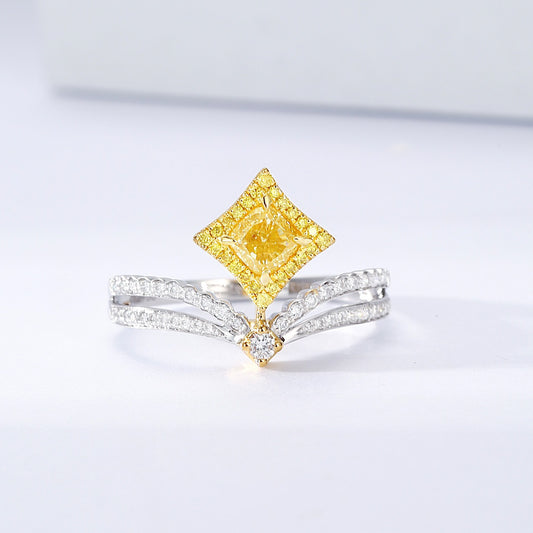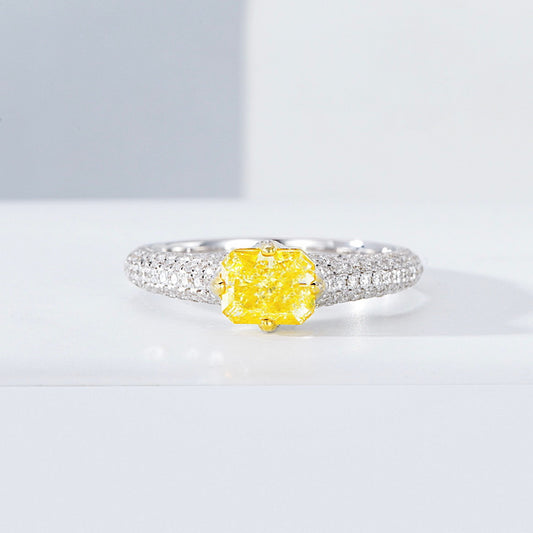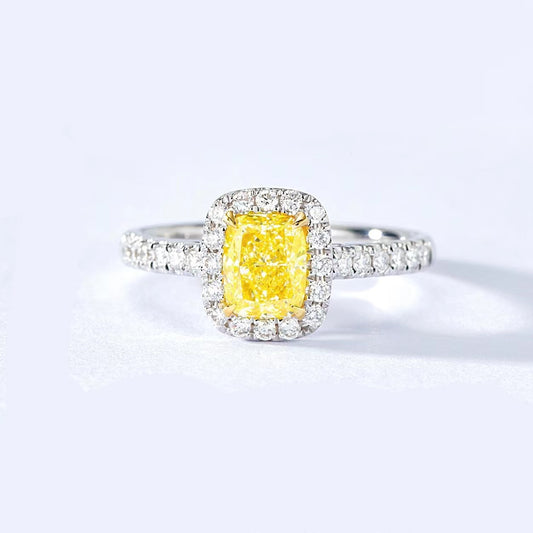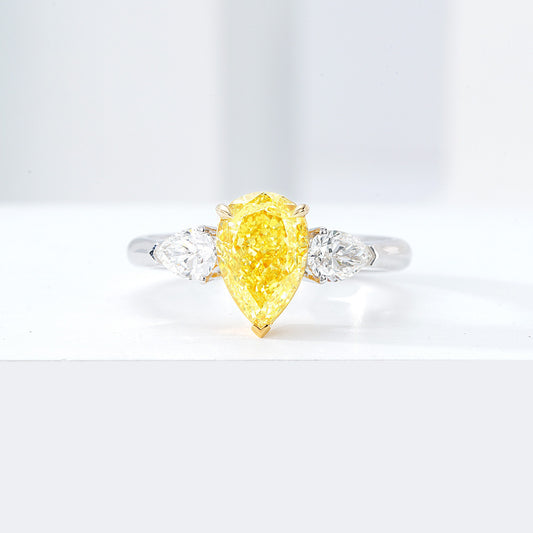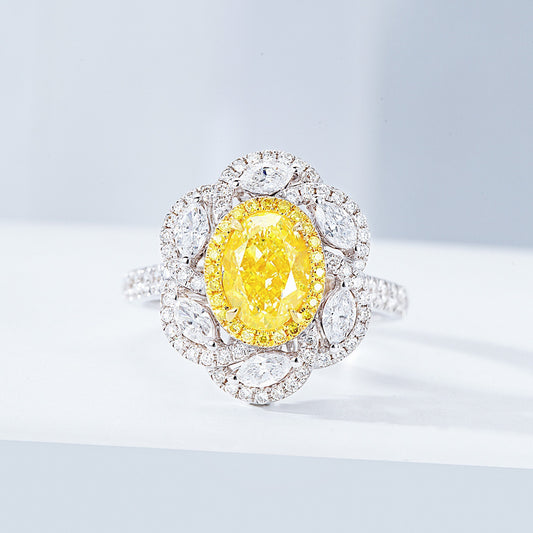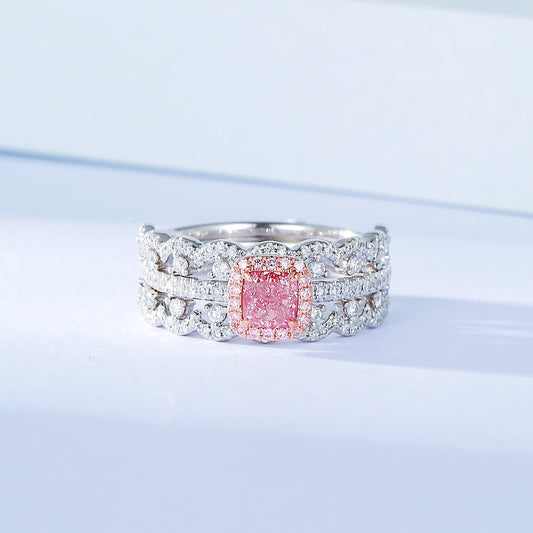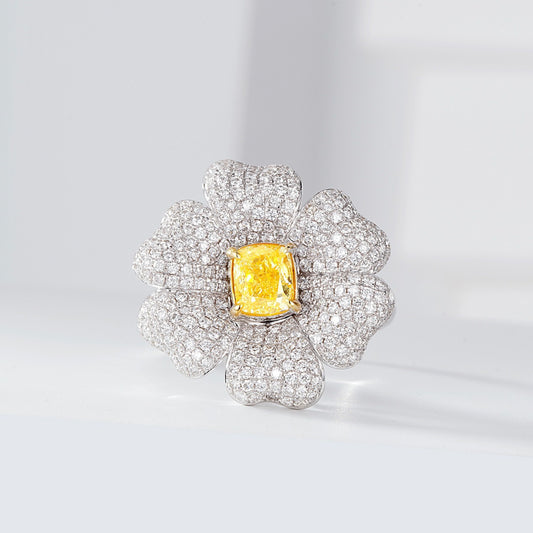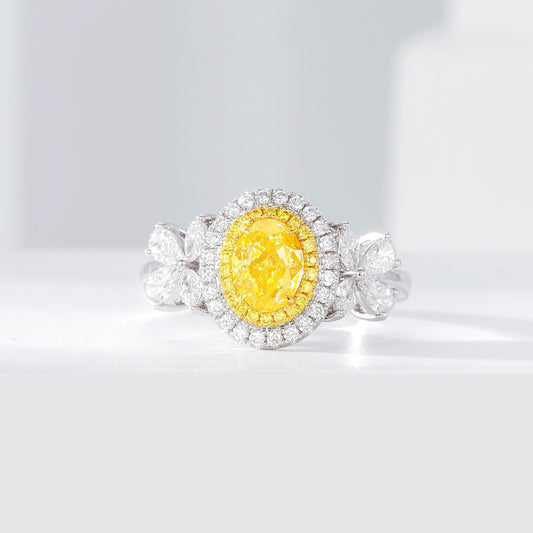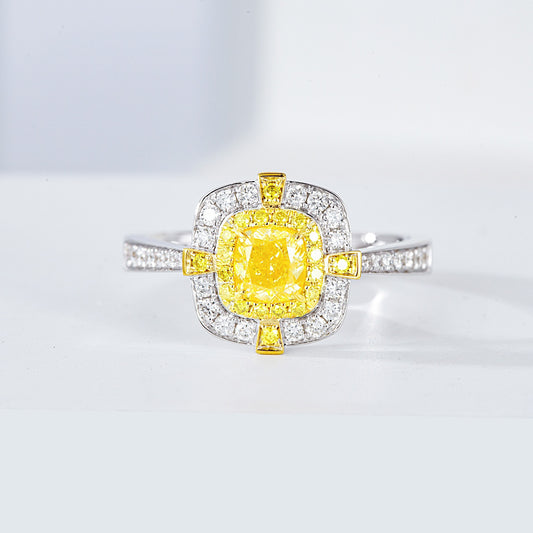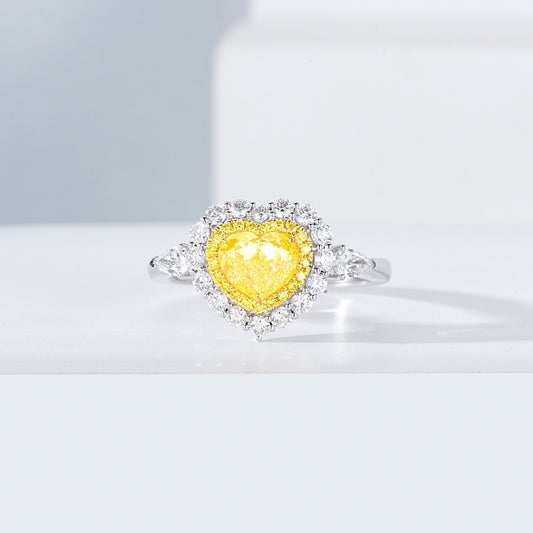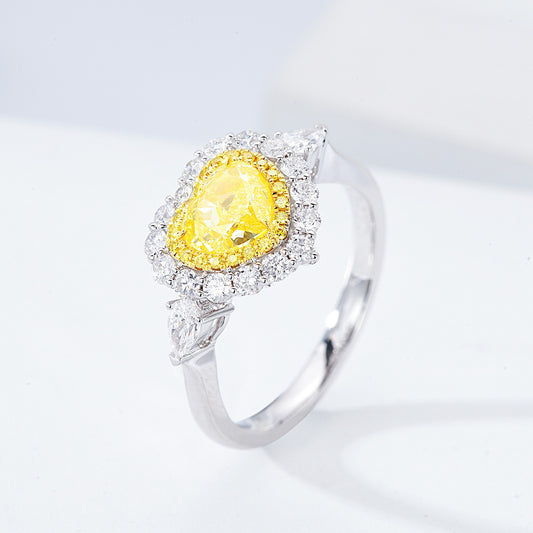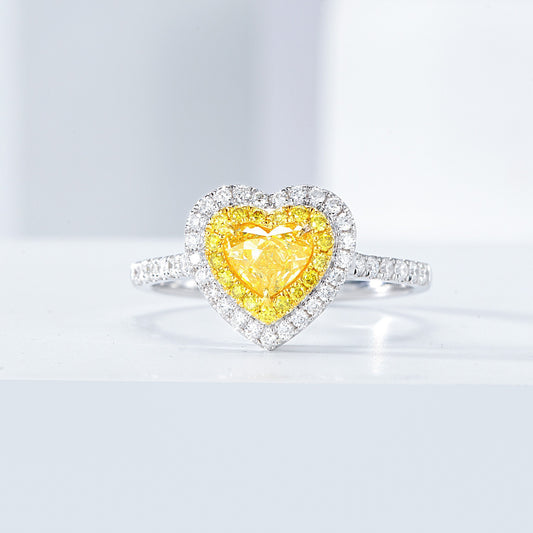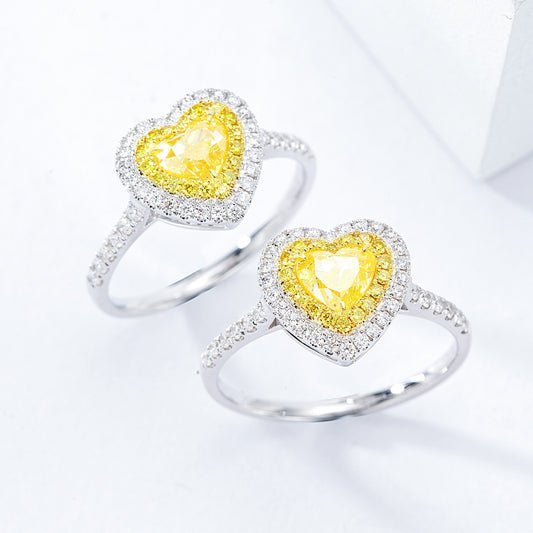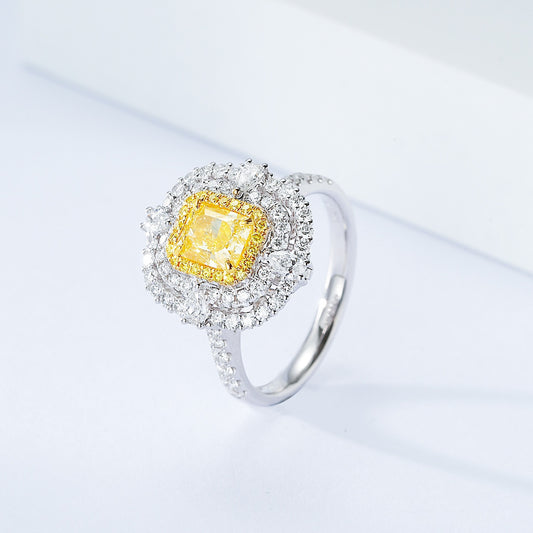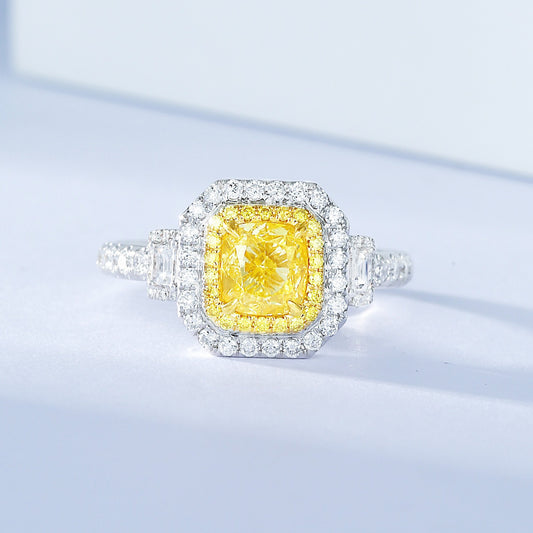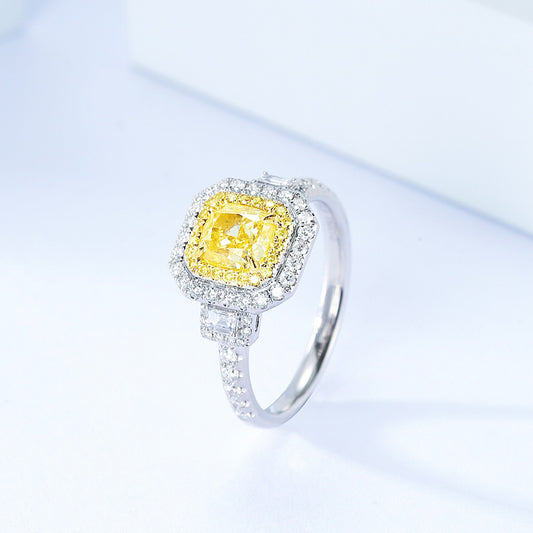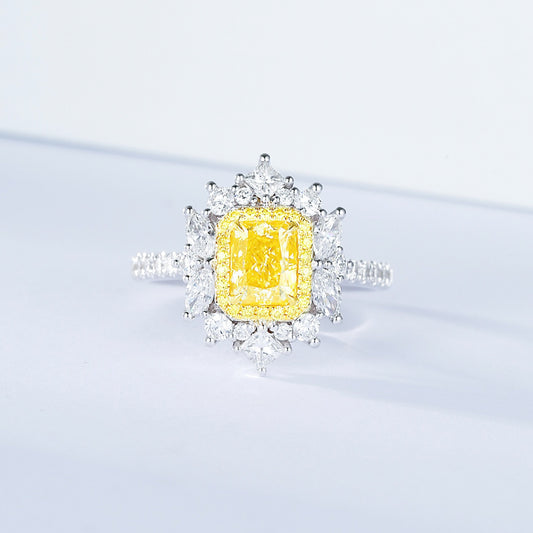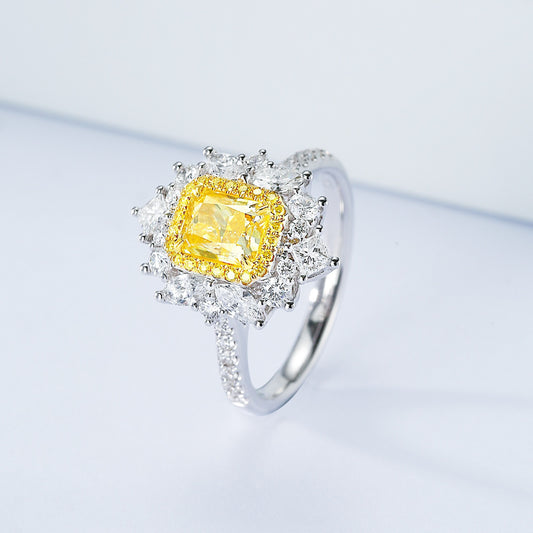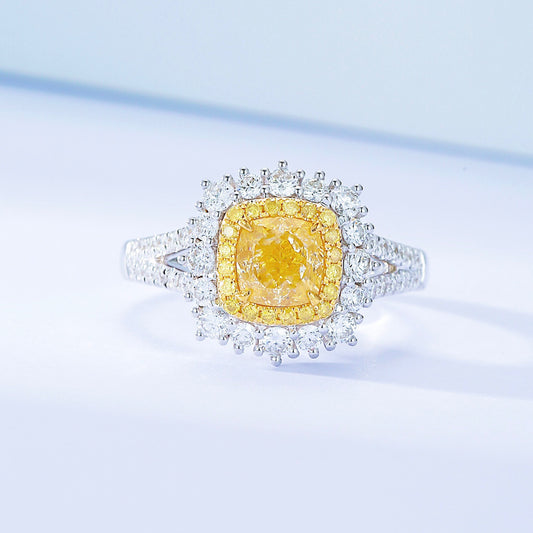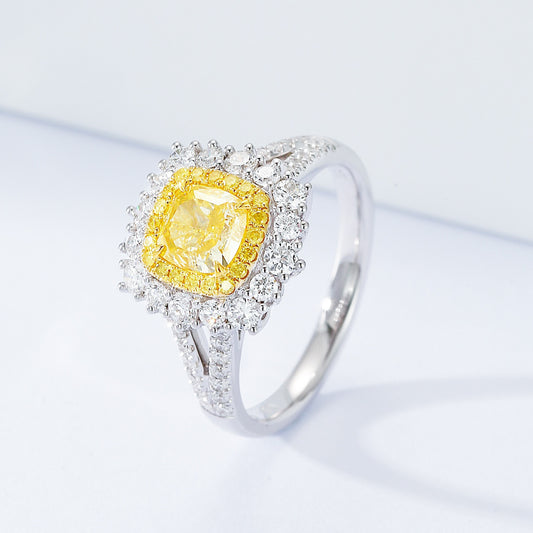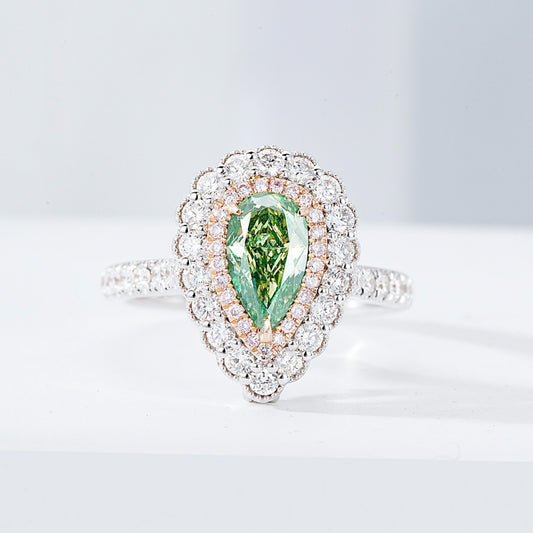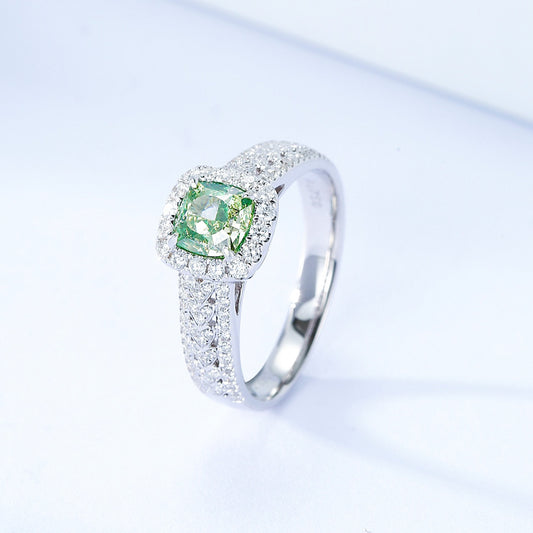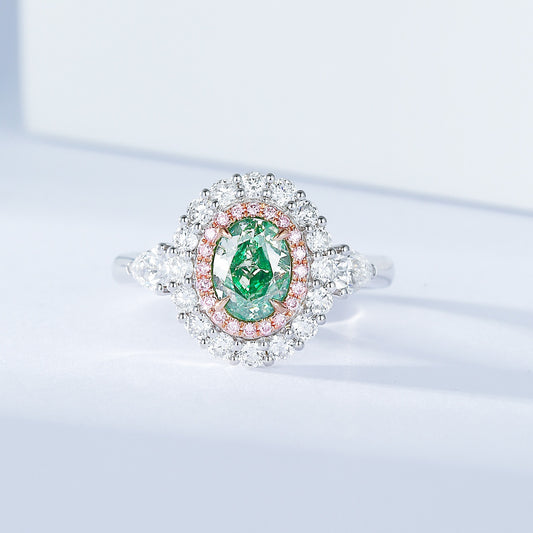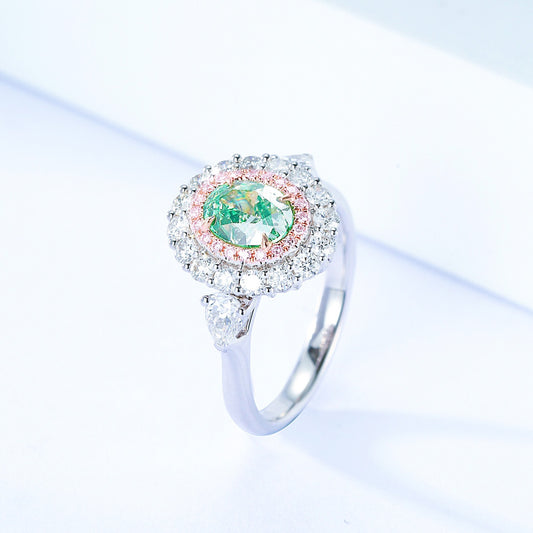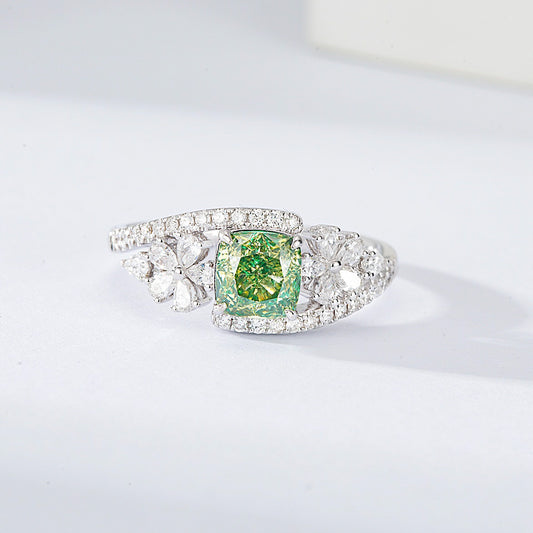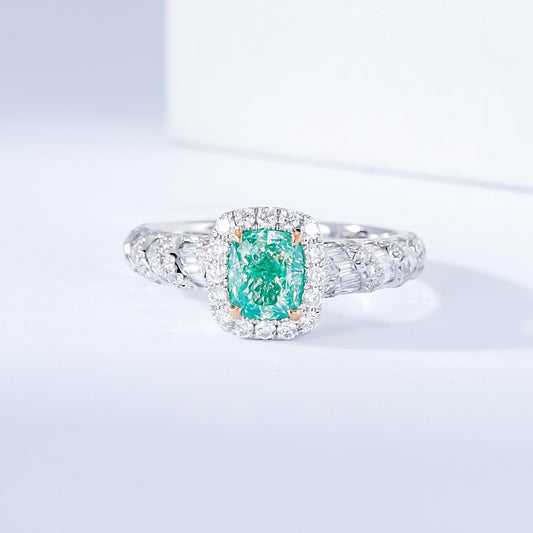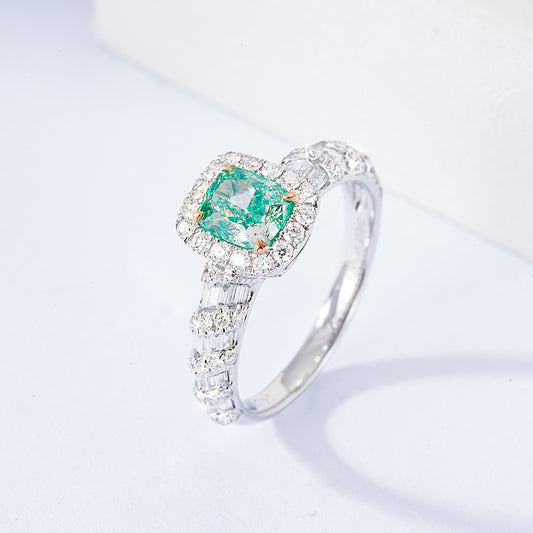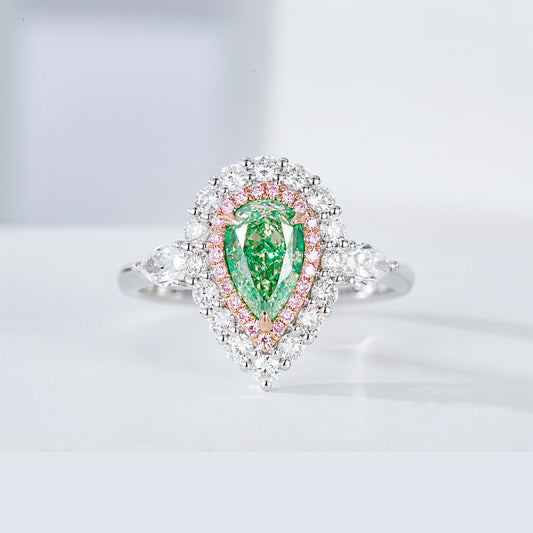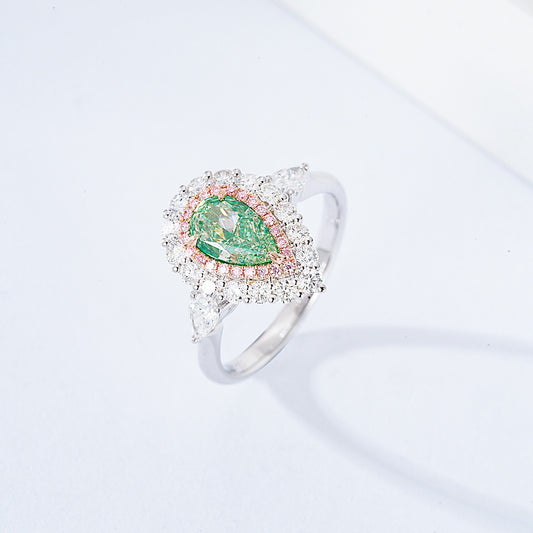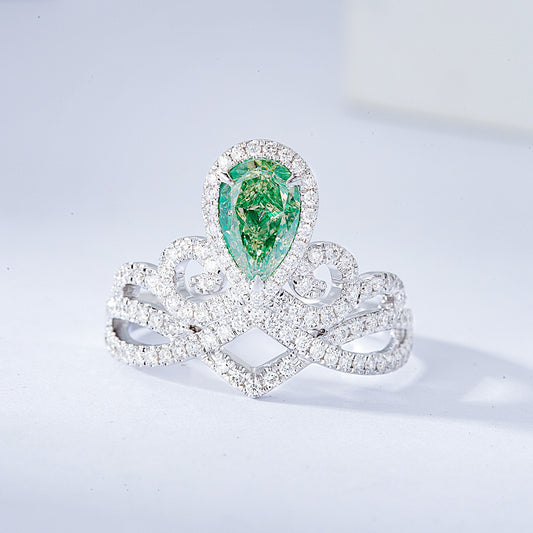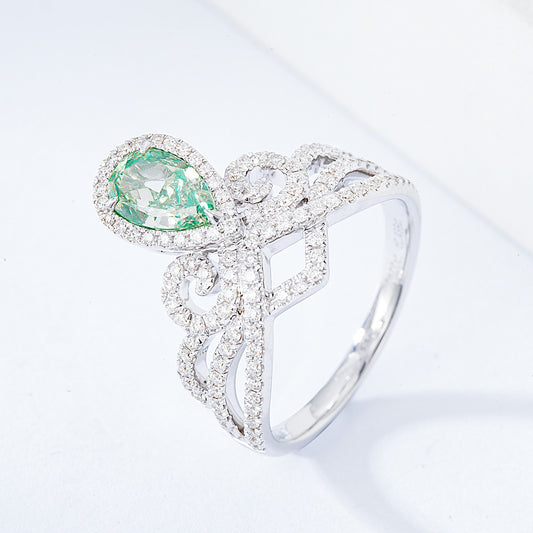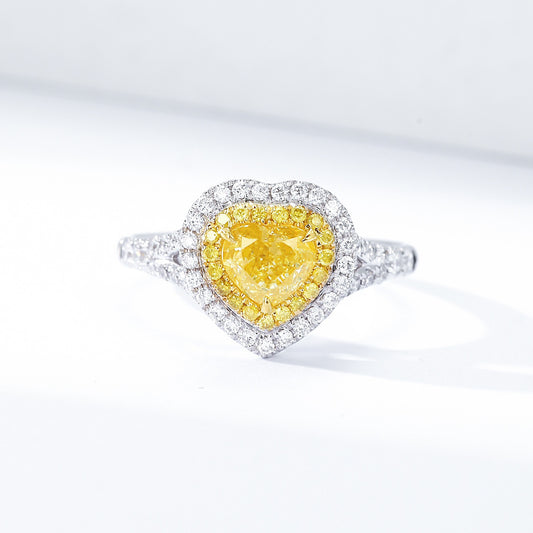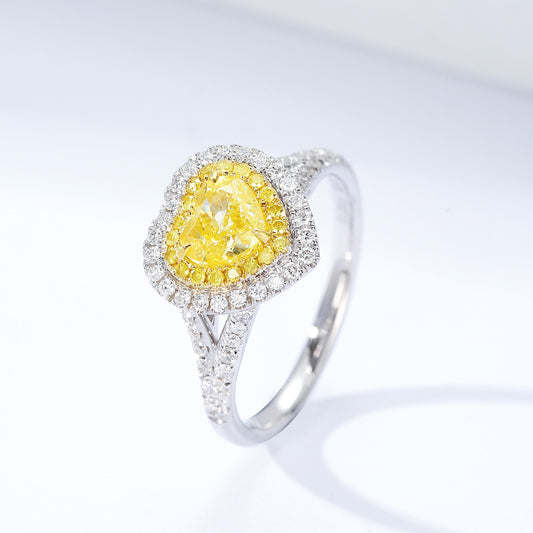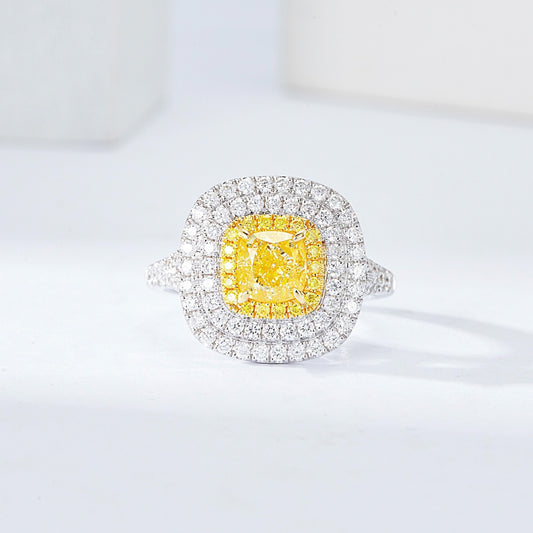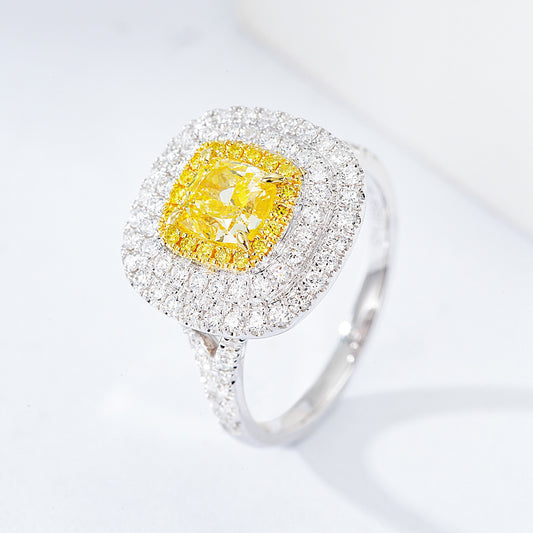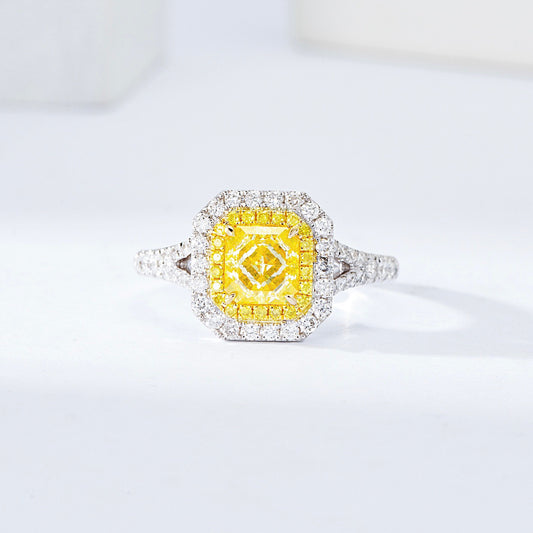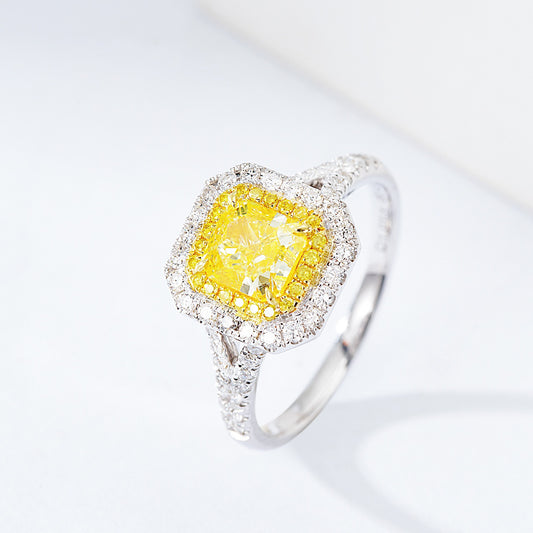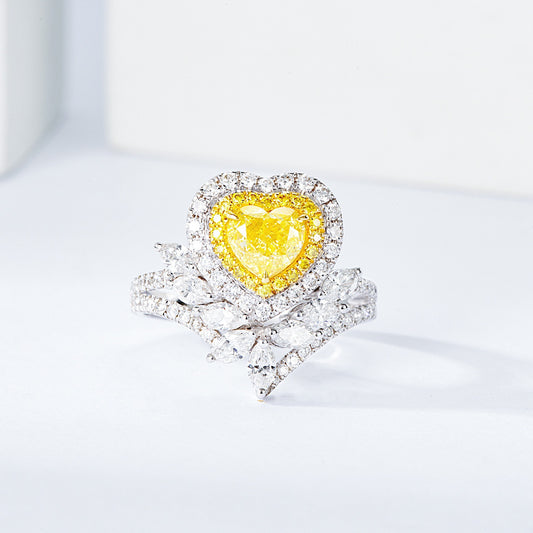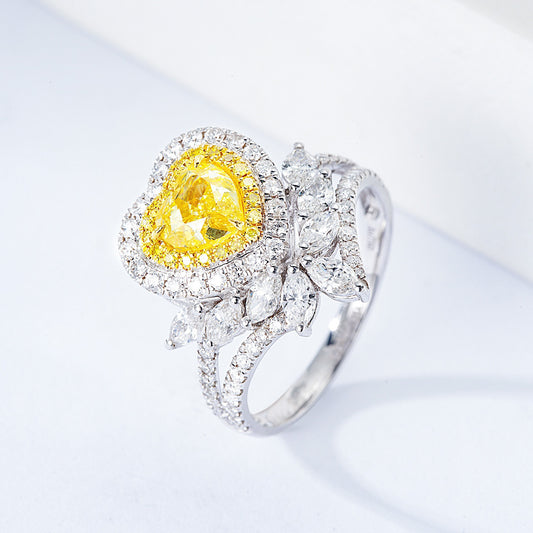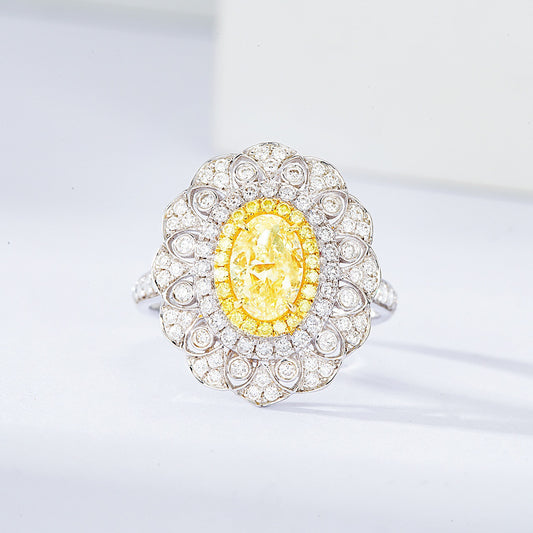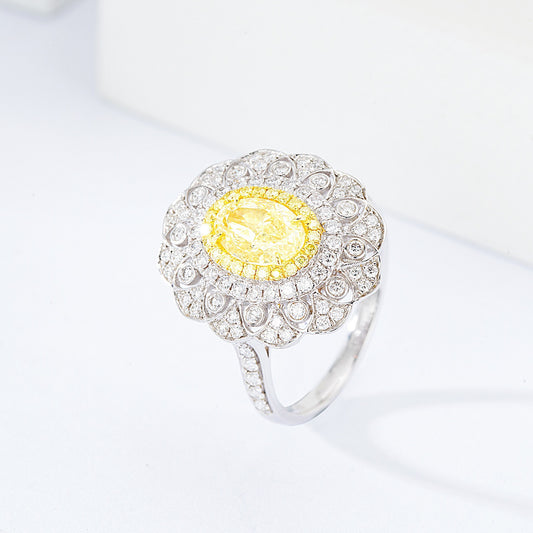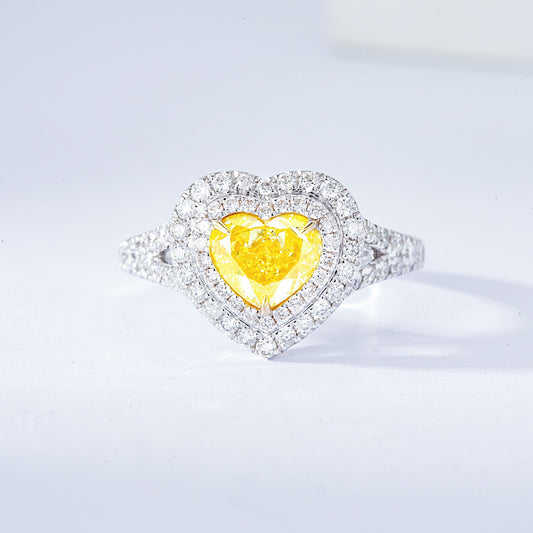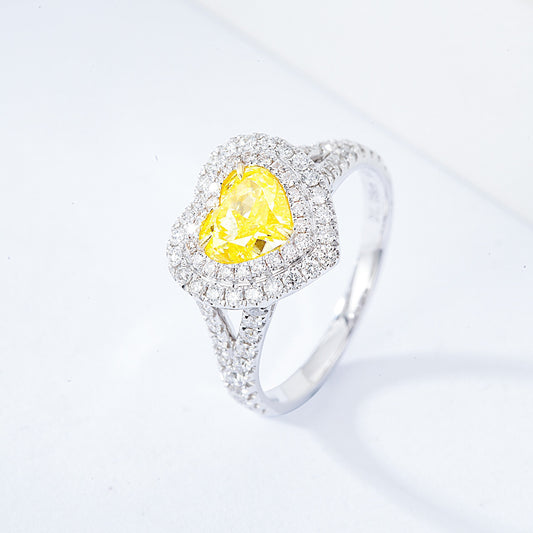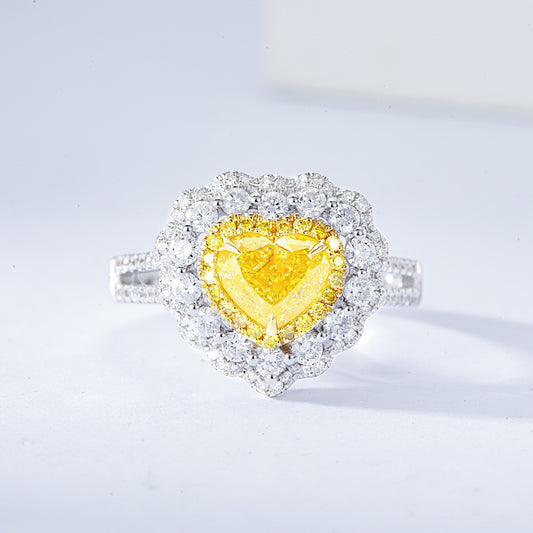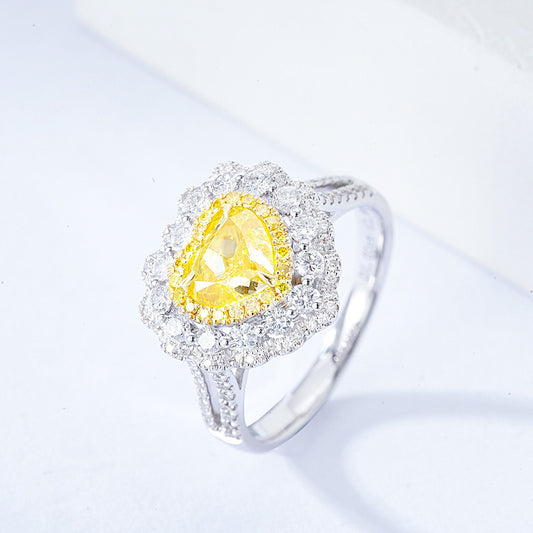-
Heart Shaped Yellow Diamond Halo Engagement Ring with Three Stone Setting
The center piece of this stunning ring is a one-carat yellow heart-shaped diamond flanked by two side diamonds that sparkle. By surrounding the vivid yellow diamond with a diamond halo, it creates an even more brilliant effect; moreover, the other small diamonds on the sides underscore its three-row design. While fashioned from sleek white gold, the ring merges the romantic appeal of the heart-shaped gemstone with the ageless beauty of three-stone models. An charming Heart Shaped Yellow Diamond Three Stone Ring with a total weight of 1.62 carats, showcasing a certified 1.00 carat heart shape diamond.- From $2,670.00
- From $2,670.00
- Unit price
- per
-
Heart Shaped Yellow Diamond Double Halo Engagement Ring with Pavé Details
A stunning luxurious and elegant statement is made by the heart shaped yellow diamond ring. The dazzling one carat yellow diamond is accented by two rows of dazzling yellow and white diamonds around the center in the ring. In addition, the detailed pavé on the band increases its brilliance making it a piece to remember forever. Displayed here is a charming Heart Shaped Yellow Diamond Double Halo Engagement Ring with a total approximate diamond weight of 1.00 carat, showcasing a 0.60 carat heart shape diamond.- From $2,620.00
- From $2,620.00
- Unit price
- per
-
Cushion Cut Yellow Diamond Double Halo Engagement Ring with Pavé Band
Beautifully set between two halos of shiny white diamonds are a double band ring with 1-carat weighted cushion cut yellow diamond on it. Pleasingly so, the intricate Pavé band makes an opulent, glamorous statement giving it an elite appearance. For those who enjoy sophistication in someone’s refined taste, this isthmus-connecting old and new fashion concepts ring is completely unique. An opulent Cushion Cut Yellow Diamond Double Halo Ring with a total weight of 1.94 carats, showcasing a certified 1.00 carat cushion cut diamond.- From $3,160.00
- From $3,160.00
- Unit price
- per
-
Cushion Cut Yellow Diamond Halo Engagement Ring with Pavé Setting in 18K White Gold
A contemporary flair is brought into play in this ring with cushion-cut yellow diamond and a touch of a classic one. The color tone of the middle stone gets alongside with its halo and thin spiraling ring, which altogether make this shining ring marvelous: 1-carat cushion yellow diamond has white and yellow diamonds surrounding it within two halos. The use of some side stones enhances its vivacity thus making it look captivating and expensive. An opulent Cushion Cut Yellow Diamond Halo Engagement Ring with a total weight of 1.58 carats, showcasing a certified 1.00 carat cushion cut diamond.- From $2,460.00
- From $2,460.00
- Unit price
- per
-
Cushion Cut Yellow Diamond Halo Engagement Ring with Pavé Setting in 18K White Gold
The central feature of this lovely ring is a 1-carat cushion cut fancy yellow diamond; it is bordered by a shimmering floral inspired halo sparkling with white diamonds. The exquisite mix of marquise and round stones gives an impression of a blossoming flower and hence makes the center stone appear more yellow. This creation combines luxury and handiwork showcased in a thin pavé band, and this is why it is best suited for individuals who love sophistication and unique styles. A luxury Cushion Cut Yellow Diamond Ring with a total weight of 2.04 carats, showcasing a certified 1.00 carat cushion cut diamond.- From $2,960.00
- From $2,960.00
- Unit price
- per
-
Cushion Cut Yellow Diamond Engagement Ring with Pavé Halo Setting in 18K White Gold
Its center is a 1 carat cushion cut yellow diamond that glows with warmth and brilliance having a mesmerizing effect to them. Around the lively yellow diamond is a shimmering halo of diamonds, giving off a different light each time the angle changes. In addition, the pavé diamond band makes it even more luxurious, thus enhancing its statement of elegance. A excellent Cushion Cut Yellow Diamond Halo Ringwith a total weight of 1.76 carats, showcasing a certified 1.00 carat cushion cut diamond.- From $2,990.00
- From $2,990.00
- Unit price
- per
-
Pear Shaped Green Diamond Halo Engagement Ring with Pavé Setting
It has an intricate design with one carat pear-shaped green diamond at its center. The central part has a fine triple lining of halos which contain pale white diamonds beside with remarkable sparkling effect. Displayed here is an exquisite Pear Shaped Green Diamond Halo Engagement Ring with a total approximate diamond weight of 1.85 carats, showcasing a 1.00 carat pear shaped diamond.- From $2,830.00
- From $2,830.00
- Unit price
- per
-
Cushion Cut Green Diamond Halo Engagement Ring with Pavé Band
This ring has a 1-carat cushion-cut green diamond which is an elegant blend of beauty and luxury that makes a statement. The bright green center stone is set on a sparkling diamond pavé band creating layers of fire and class. The juxtaposition of rare colored diamonds in this case against a traditional design is what makes it unique in appearance sense. Displayed here is an exquisite Cushion Cut Green Diamond Halo Engagement Ring with a total approximate diamond weight of 1.41 carats, showcasing a 1.00 carat cushion cut diamond.- From $2,980.00
- From $2,980.00
- Unit price
- per
-
Oval Cut Green Diamond Halo Engagement Ring with Three Stone Setting
This remarkable three-stone ring has a design in the center featuring a 1 carat oval green diamond and two other side stones adding to its glow. The center stone is exhibiting a vista of vivid green surrounded by overlapping double layers of sparkling white and pink diamonds, creating a beautiful contrast. The elaborate designs of the band and the three stone arrangement are meaningful as they represent the past, present and future making it a perfect piece for any event. An exquisite Oval Green Diamond Three Stone Ring with a total weight of 1.97 carats, showcasing a certified 1.00 carat oval diamond.- From $2,980.00
- From $2,980.00
- Unit price
- per
-
Cushion Cut Green Diamond Engagement Ring with Pavé Setting
At the core of this exquisite piece lies a 1 carat cushion cut green diamond with nature themed embellishments all around. The band comprises of a floral design that is embellished with white diamonds giving a soft, feminine, organic quality to the overall look. The cushion cut emerald green diamond stands out beautifully in this intricate design making the precious ring an exquisite representation of grace and natural beauty. An exquisite Cushion Cut Green Diamond Nature-Inspired Ring with a total weight of 1.46 carats, showcasing a certified 1.00 carat cushion cut diamond.- From $2,990.00
- From $2,990.00
- Unit price
- per
-
Cushion Cut Green Diamond Halo Engagement Ring with Baguette Cut Accents
The centerpiece of this breathtaking ring is a one-carat green diamond cut into a cushion shape. The diamond is complemented by a dazzling halo of white diamonds around it. The elaborate design is further enhanced by a band set with pave diamonds, adding more glamour and elegance to the overall design. The vivid green of the cushion cut diamond is very striking making it ideal for a person who loves color and has a unique sense of style as this ring is quite attention-grabbing. An exquisite Cushion Cut Green Diamond Halo Engagement Ring with a total weight of 1.65 carats, showcasing a certified 1.00 carat cushion cut diamond.- From $2,980.00
- From $2,980.00
- Unit price
- per
-
Pear Shaped Green Diamond Halo Engagement Ring with Three Stone Setting
This enthralling ring showcases a 1 carat pear-shaped green diamond embraced by an eye-catching double halo embellished with white and pink diamonds. The halo enhances the sparkle of the center stone and is designed in a three-stone arrangement with two beautiful side diamonds that offer symmetry and style. It comes as no surprise that those who desire a timeless ring with a contemporary aesthetic will find this a must-have any jewelry collection. An exquisite Pear-Shaped Green Diamond Halo Three Stone Engagement Ring with a total weight of 1.89 carats, showcasing a certified 1.00 carat pear shape diamond.- From $2,890.00
- From $2,890.00
- Unit price
- per
-
Pear Shaped Green Diamond Crown Inspired Engagement Ring
A green diamond ring with a 1-carat pear-shaped diamond in a crown setting. There is a highly ornamental diamond studded band surrounding the centre stone that oozes elegance and grandeur with the help of intricate carving. For those who enjoy traditional and vintage styles while seeking out modern elements, this ring is a distinctive and timeless creation that is bold in beauty and elegance. A captivating Pear Shaped Green Diamond Crown-Inspired Ring with a total weight of 1.49 carats, showcasing a certified 1.00 carat pear shape diamond.- From $3,250.00
- From $3,250.00
- Unit price
- per
-
Heart Shaped Yellow Diamond Halo Engagement Ring in 18k White Gold
This alluringly heart shaped Natural yellow diamond surrounding by suitable halo of white diamonds engagement ring in exquisite 18K white gold setting. Luxurious white gold contrasts with the beautiful yellow center stone in the shape of a heart, creating a stunning visual contrast all around the center stone. It's a gem of a ring, and will take the recipient's breath away. A captivating Heart Shaped Yellow Diamond Engagement Ring with a total weight of 1.49 carats, showcasing a 1.00 carat heart shape diamond and pavé diamond band.- From $2,670.00
- From $2,670.00
- Unit price
- per
-
Cushion Cut Yellow Diamond Triple Halo Engagement Ring with Pavé Setting - 1.00 Carat
This cushion cut yellow diamond ring embeds you in ultimate luxury, being highly deluxe and fancy. The design of both the gold and the sides of central cushion cut yellow diamond is rather classical. The ring also has three flashy halos, one on every side of the main diamond. The setting on the side completes the design with some brilliance and splendor.The entire ring features diamonds with fine gold chain enveloping the center yellow diamond and diamonds along the sides which make it a pavé band. A captivating Cushion Cut Yellow Diamond Ring, showcasing a cushion cut diamond.- From $3,280.00
- From $3,280.00
- Unit price
- per
-
1.00 Carat
-
1.50 Carat
-
Radiant Cut Yellow Diamond Halo Engagement Ring with Split Shank Design
The beauty and brilliance of the radiant yellow diamond engagement ring are sure to make the recipient the happiest person on earth. I further added two rows of melee diamonds in yellow and white forming another halo for increased shine and to frame the yellow diamond. The shank is further split and this gives even more alluring effect thanks to the added white diamonds. A elegant Radiant Cut Yellow Diamond Halo Engagement Ring with a total weight of 1.45 carats, showcasing a certified 1.00 carat radiant cut diamond.- From $2,970.00
- From $2,970.00
- Unit price
- per
-
Heart Shaped Yellow Diamond Engagement Ring with Floral Inspired Diamond Accents
Quintessentially glamorous and iconic in love, this piece showcases heart-shaped yellow diamond ring. It is comprised of a yellow center stone, enveloped by two halos of white and yellow stones which work in tandem giving off a warm and inviting feeling, even at a glance. All in all, the ring resembles to engraved ring vintage. The two-tiered shank features painted floral diamond elements, creating an ocean but uniting two different parts in the flowing waters. A elegant Heart Shaped Yellow Diamond Engagement Ring with a total weight of 2.70 carats, showcasing a certified 1.00 carat heart shape diamond.- From $3,290.00
- From $3,290.00
- Unit price
- per
-
Oval Yellow Diamond Engagement Ring with Floral Halo Design
A remarkable piece, this ring features an oval-cut Yellow diamond, and is designed with intricate elements of color and structural sophistication. The center stone, an oval modified brilliant-cut natural Yellow diamond, is settled within a bezel fitted in a Brilliant pave-set diamonds, Yellow as well as White in color. The bezel setting has rails set in metalwork at the sides creating a petal setting for the dazzling diamond center stone surrounded by the naturalist image of the floral motif. All elements are expressed not only by the beautiful design which gives the piece an undeniable luxurious appeal, but also by the exquisite layering and intricately executed embellishments found in every petal and leaf. A elegant Oval Yellow Diamond Ring with a total weight of 1.75 carats, showcasing a certified 1.00 carat oval shape diamond.- From $2,980.00
- From $2,980.00
- Unit price
- per
-
Heart Shaped Yellow Diamond Engagement Ring with Pavé and Halo Setting
This genuinely mesmerizing ring comprises of a striking yellow diamond heart shaped stone weighing 1 carat nested amidst two glittering circular layers of diamonds. The fiery color of the diamond is complimented exceptionally by the white stones, inspired by the warmth of love and opulence. An charming Heart-Shaped Yellow Diamond Ring with a total weight of 1,62 carats, showcasing a certified 1.00 carat heart shape diamond.- From $2,790.00
- From $2,790.00
- Unit price
- per
-
Heart Shaped Yellow Diamond Engagement Ring with Pavé Halo Setting
This genuinely mesmerizing ring comprises of a striking yellow diamond heart shaped stone weighing 1 carat nested amidst two glittering circular layers of diamonds. The fiery color of the diamond is complimented exceptionally by the white stones, inspired by the warmth of love and opulence. An charming Heart-Shaped Yellow Diamond Ring with a total weight of 1,68 carats, showcasing a 1.00 carat heart shape diamond.- From $2,990.00
- From $2,990.00
- Unit price
- per
1 Carat Engagement Rings
1-carat engagement rings featuring fancy colored diamonds offer a unique blend of elegance and individuality. These rings showcase diamonds in a variety of captivating hues, such as yellow, pink, and more, making each piece truly one-of-a-kind. The 1-carat size provides a perfect balance between presence and wearability, allowing the vibrant color of the diamond to be the focal point while still offering a substantial and eye-catching look.
Our collection of 1-carat fancy colored diamond rings is designed to highlight the natural beauty and rarity of these exquisite stones. Whether set in a classic solitaire, surrounded by a halo of accent diamonds, or incorporated into a more intricate design, these rings are perfect for those who want a distinctive and memorable symbol of their love. With a 1-carat fancy colored diamond, you can enjoy both the timeless appeal of a diamond and the added allure of a striking, vibrant color.
Explore Related Pages
Shop All Engagement Rings
Shop Yellow Gold Engagement Rings
Shop 1 Carat Engagement Rings
Shop 2 Carat Engagement Rings
Shop Yellow Diamond Engagement Rings
Shop Pink Diamond Engagement Rings
Shop Green Diamond Engagement Rings
Shop Luxe Engagement Rings
Shop Nature Inspired Engagement Rings
Shop Vintage Engagement Rings
Learn about Engagement Ring Settings and Styles
FAQs about 1 Carat Diamond Engagement Rings
Yes, 1 carat is a very good size for an engagement ring and is often considered the classic choice. A 1-carat diamond offers a great balance between size, brilliance, and affordability, making it a popular option for many couples. It provides a noticeable sparkle without being overly large, making it versatile and suitable for various ring settings and styles.
While the perfect size is subjective and depends on personal preferences and budget, a 1-carat diamond is widely regarded as an ideal and timeless choice for an engagement ring.
Yes, getting a 1-carat diamond is often considered worth it for several reasons:
- Classic Size: A 1-carat diamond is a classic and popular choice, providing a noticeable size that still feels elegant and timeless. It’s large enough to make an impact but not so big that it becomes overly flashy or difficult to wear daily.
- Balance of Cost and Appearance: A 1-carat diamond offers a good balance between size and cost. While diamonds can become significantly more expensive as they increase in size, a 1-carat stone is typically more affordable than larger diamonds, while still offering impressive brilliance and presence.
- Versatility:A 1-carat diamond works well with various settings, from solitaires to halo or pavé designs, making it versatile and adaptable to different styles.
- Investment Value: While diamonds are not necessarily the best financial investment, a well-cut, high-quality 1-carat diamond can retain its value and be a lasting symbol of commitment.
Ultimately, whether it's 'worth it' depends on your personal preferences, budget, and what you’re looking for in an engagement ring. However, for many, a 1-carat diamond is a meaningful and well-balanced choice.
When purchasing a colored diamond ring, several factors influence its value and appeal:
- Diamond Color: The color of the diamond is a key factor in determining its beauty and price. Colored diamonds, such as yellow and pink diamonds, come in a range of shades. Yellow diamonds are generally more affordable than pink Diamonds, as pink diamonds are rarer and more sought after. The intensity of the color also plays a significant role—the deeper and more vivid the color, the higher the value of the diamond.
- Ring Design: The design and setting of the ring greatly impact its overall cost. Luxurious and intricate settings, often featuring additional diamonds or custom craftsmanship, tend to be more expensive. A well-designed setting can enhance the beauty of the colored diamond, making it stand out even more. Whether you choose a simple solitaire or a more elaborate design, the ring setting is a crucial element in showcasing the diamond’s color and brilliance.
- Diamond Origin: When deciding how much to spend on a 1-carat diamond, it’s important to consider whether you prefer a natural or lab-grown diamond, as this choice significantly affects the price. Natural diamonds, formed over millions of years, are rarer and often more expensive, typically ranging from $5,000 to $15,000 or more for a high-quality stone. They are valued for their uniqueness and timeless symbolism. On the other hand, lab-grown diamonds, which possess the same physical and chemical properties as natural diamonds, are more affordable—usually 30-40% less expensive—ranging from $2,500 to $6,000. With advancements in technology, lab-grown diamonds offer exceptional quality and a more budget-friendly option without sacrificing beauty or brilliance. The choice between the two depends on your priorities—whether you value the rarity and tradition of a natural diamond or the cost-effectiveness and modern appeal of a lab-grown one.
These considerations will help you make an informed decision when selecting the perfect colored diamond ring.
Whether a 1-carat diamond looks small depends on several factors, including the diamond's shape, cut, and the design of the ring:
- Shape and Cut: The shape and cut of a diamond significantly influence how large it appears. For example, elongated shapes like oval, cushion, or pear can make a 1-carat diamond look larger than round or square shapes. Additionally, a well-cut diamond with excellent proportions will reflect light better, enhancing its visual size and brilliance.
- Ring Design: The design of the engagement ring also plays a crucial role in how big a 1-carat diamond appears. Settings like a halo, where smaller diamonds surround the center stone, or luxe designs with intricate details, can make the diamond look larger. These settings create an illusion of more size and add to the overall impact of the ring. In contrast, simpler solitaire settings may not enhance the diamond's size as much, making it look smaller by comparison.
So, while a 1-carat diamond may seem small in some settings, the right cut and design can make it appear much larger.
The best carat diamond for an engagement ring depends on several factors, including personal preference, budget, and the ring design. Here are some considerations:
- Personal Preference: The ideal carat weight varies from person to person. Some may prefer a subtle, delicate look with a smaller diamond, while others may want a more prominent, eye-catching stone. Common carat sizes for engagement rings range from 0.5 to 2 carats, with 1 carat being a popular choice that balances size and affordability.
- Budget: Carat weight significantly impacts the price of a diamond. Larger diamonds are rarer and more expensive, so it’s essential to find a balance between size and what you can afford. For many, a 1-carat diamond offers a good compromise between cost and appearance, while those with a larger budget may opt for a 1.5 to 2-carat stone or more.
- Ring Design: The ring’s design also influences the perceived size of the diamond. Certain settings, like haloor pavé designs, can make a smaller diamond appear larger, allowing you to choose a slightly smaller carat weight without sacrificing visual impact.
Ultimately, the best carat weight is one that aligns with your personal style, budget, and the overall design of the ring. There’s no one-size-fits-all answer, as the ideal carat weight is a highly individual choice.
Whether a 1-carat or 2-carat diamond is better depends on several factors, including personal preference, budget, and the desired appearance of the ring:
Size and Impact:
- 2 Carat: A 2-carat diamond is significantly larger and will have a more noticeable presence on the finger. It’s ideal for those who want a statement piece that stands out and makes a bold impact.
- 1 Carat: A 1-carat diamond is a classic choice that offers a good balance between size and subtle elegance. It’s more understated but still provides plenty of sparkle and beauty.
Budget:
- 2 Carat: A 2-carat diamond is much more expensive than a 1-carat diamond. The price increases substantially as the carat weight goes up, especially if the diamond has high grades in cut, color, and clarity.
- 1 Carat: A 1-carat diamond is more budget-friendly, allowing for higher quality in other aspects like cut and clarity without exceeding your budget.
Ring Design:
- 2 Carat: A 2-carat diamond often pairs well with simpler settings, as the diamond itself is the main focal point. However, it can also be set in more intricate designs for an even more luxurious look.
- 1 Carat: A 1-carat diamond can be enhanced with design features like a halo or pavé setting to make it appear larger and more dazzling, giving it a more substantial look.
Final Thoughts:
If you prioritize a larger, more prominent diamond and have the budget to support it, a 2-carat diamond may be the better choice. However, if you prefer a more classic and budget-conscious option that still offers plenty of sparkle, a 1-carat diamond is an excellent choice. The 'better' option ultimately depends on your personal style, budget, and what you value most in an engagement ring.
To make your engagement ring look more expensive, consider the following tips:
- Choose a Halo Setting: A halo setting, where smaller diamonds surround the center stone, creates an illusion of a larger, more radiant diamond. This design not only enhances the sparkle but also adds an element of luxury and sophistication to the ring, making it appear more expensive.
- Opt for Luxe Design Styles: Rings with intricate, luxe designs such as pavé bands, split shanks, or vintage-inspired details—add an extra layer of elegance and complexity. These design elements draw attention to the craftsmanship and overall beauty of the ring, giving it a more opulent appearance.
- Select Larger-Appearing Diamond Shapes: Certain diamond shapes, like oval, cushion, or pear, tend to look larger than their actual carat weight. These shapes elongate and maximize the diamond’s surface area, making the ring feel more substantial and luxurious.
By combining a halo setting with a luxe design and a larger-appearing diamond shape, you can create an engagement ring that exudes elegance and appears more expensive than it actually is.
- Choosing a selection results in a full page refresh.
